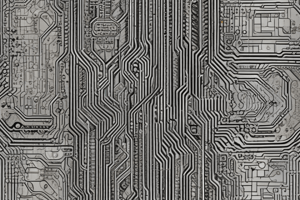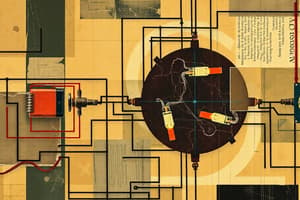Podcast
Questions and Answers
In a series circuit, how is the total voltage calculated?
In a series circuit, how is the total voltage calculated?
- It is the sum of the voltages across each load. (correct)
- It is the average of all voltages.
- It is the minimum voltage among the loads.
- It is the product of the voltages.
In a parallel circuit, the voltage across each load is different.
In a parallel circuit, the voltage across each load is different.
False (B)
What happens to the current in a parallel circuit as more devices are added?
What happens to the current in a parallel circuit as more devices are added?
The total current increases.
In series circuits, increasing the voltage will cause the bulbs to burn __________.
In series circuits, increasing the voltage will cause the bulbs to burn __________.
Match the following circuit components with their functions:
Match the following circuit components with their functions:
What is a disadvantage of a series circuit?
What is a disadvantage of a series circuit?
Adding more loads in a parallel circuit decreases the total current.
Adding more loads in a parallel circuit decreases the total current.
What issue can arise from increased current in a parallel circuit?
What issue can arise from increased current in a parallel circuit?
The equation for total current in a parallel circuit is __________.
The equation for total current in a parallel circuit is __________.
What is the function of a resistor in a circuit?
What is the function of a resistor in a circuit?
What happens to the total resistance in a series circuit as additional loads are added?
What happens to the total resistance in a series circuit as additional loads are added?
In a parallel circuit, a break in one pathway affects the other pathways.
In a parallel circuit, a break in one pathway affects the other pathways.
What is the primary characteristic of a series circuit?
What is the primary characteristic of a series circuit?
In a parallel circuit, total resistance ______ as loads are added.
In a parallel circuit, total resistance ______ as loads are added.
Match the following circuit types with their characteristics:
Match the following circuit types with their characteristics:
What remains the same throughout a series circuit?
What remains the same throughout a series circuit?
What is the effect of adding an extra lane in a parallel circuit during rush hour?
What is the effect of adding an extra lane in a parallel circuit during rush hour?
Fuses are typically wired in parallel to control the entire circuit.
Fuses are typically wired in parallel to control the entire circuit.
The ______ provides the energy/force needed to supply all of the loads in a series circuit.
The ______ provides the energy/force needed to supply all of the loads in a series circuit.
Describe the effect of adding more loads in a series circuit.
Describe the effect of adding more loads in a series circuit.
Flashcards
Series Circuit
Series Circuit
A circuit where electrons flow along a single path.
Parallel Circuit
Parallel Circuit
A circuit with multiple pathways for electrons to flow.
Resistance in a Series Circuit
Resistance in a Series Circuit
The total resistance in a series circuit increases as more loads are added.
Resistance in a Parallel Circuit
Resistance in a Parallel Circuit
Signup and view all the flashcards
Current in a Series Circuit
Current in a Series Circuit
Signup and view all the flashcards
Voltage in a Series Circuit
Voltage in a Series Circuit
Signup and view all the flashcards
Voltage in a Parallel Circuit
Voltage in a Parallel Circuit
Signup and view all the flashcards
Current in a Parallel Circuit
Current in a Parallel Circuit
Signup and view all the flashcards
Switch
Switch
Signup and view all the flashcards
Fuse
Fuse
Signup and view all the flashcards
Total Voltage (Series)
Total Voltage (Series)
Signup and view all the flashcards
Current (Series)
Current (Series)
Signup and view all the flashcards
Total Current (Parallel)
Total Current (Parallel)
Signup and view all the flashcards
Voltage (Parallel)
Voltage (Parallel)
Signup and view all the flashcards
Series Circuit Disadvantage
Series Circuit Disadvantage
Signup and view all the flashcards
Parallel Circuit Disadvantage
Parallel Circuit Disadvantage
Signup and view all the flashcards
Fuses and Circuit Breakers
Fuses and Circuit Breakers
Signup and view all the flashcards
Circuit Breaker
Circuit Breaker
Signup and view all the flashcards
Blown Fuse or Tripped Breaker
Blown Fuse or Tripped Breaker
Signup and view all the flashcards
Study Notes
Grade 9 Science, Academic - Lesson 11.2 - Voltage and Current in Series and Parallel Circuits
- Learning Goals: Understand how electrical circuits are designed using series and parallel configurations.
- Success Criteria:
- Explain the difference between series and parallel circuits.
- Use circuit symbols to draw circuit diagrams.
- Explain how voltage (V), current (I), and resistance (R) are affected by the number of loads in a circuit.
- Recap: Review of potential difference, current, and resistance.
- Note Format: First series circuits, then parallel, to aid comparing/contrasting.
- Series Circuits:
- One path for electron flow.
- If one part of the circuit is open, electron flow stops.
- Total resistance increases as loads are added (equivalent to adding more hurdles).
- Parallel Circuits:
- Electrons can flow through multiple paths.
- A break in one path doesn't affect the others.
- Total resistance decreases as loads are added (like adding extra lanes to prevent traffic congestion).
- Combination Circuits:
- Some circuits use both series and parallel components.
- Switches and fuses are often wired in series to control/protect the entire circuit.
- Circuit Symbols:
- Diagrams showing fuses, circuit breakers, switches etc.
- Practice Problems:
- Draw a circuit with a 2-cell battery, resistor and light bulb in series. Show correct polarity and electron flow.
- Draw a circuit with a 4.5 volt battery, two bulbs and a resistor in parallel, also including a fuse.
- Series Circuit Current:
- Current is the same throughout the entire circuit.
- Total current = current through every part of the circuit.
- Series Circuit Voltage:
- Voltage is the sum of the voltage across each load.
- Total voltage = the sum of the voltages across each component.
- Parallel Circuit Current:
- Current is shared throughout the circuit and is equal to the sum of individual branch current.
- Total current = sum of the currents through all branches.
- Parallel Circuit Voltage:
- Voltage is the same across each branch. All components use the same total supplied voltage.
- Voltage and Current Relationships
- Series Circuits: Disadvantages—If one component fails, the entire circuit is interrupted.
- Parallel Circuits: Disadvantages—Adding more loads increases the current, risking overheating wires and causing a fire.
- Safety devices (fuses/circuit breakers) are used to prevent these problems in home circuits. Their purpose is to interrupt the circuit if a high current is detected.
- Practice: Circuit Analysis: Solve problems involving missing values in series or parallel circuits.
Studying That Suits You
Use AI to generate personalized quizzes and flashcards to suit your learning preferences.




